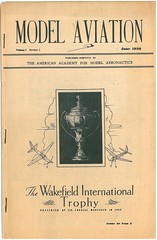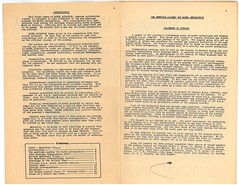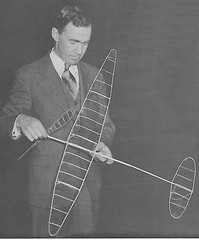Week 4 – January 27, 2011: Model Aviation Comics
The fun of model aviation has long been expressed in comic strip form. Here’s a few of them, picked rather at random, because if we printed every funny one, you’d be scrolling down forever!
Click the images to enlarge
1. A woman’s hat is a motor-driven propeller that helps her cross over puddles on the street, 1916. (Source: National Model Aviation Museum Library [“Some Sense to this Easter Bonnet,” Aerial Age Weekly, May 15, 1916.])
2. A pilot tries to land his R/C float plane in a bucket, to bad results, 1984. (Source: National Model Aviation Museum Library. [“Puddle Master,” Model Aviation, February 1984, pg. 38.])
3. A newly wed man dreams of all the free time he has now that he doesn’t have to date, 1954. (Source: National Model Aviation Museum Library [“Just Married,” Model Aviation, March 1954, pg. 7.])
4. Sometimes you can go too far after smelling glue too long, 1984. (Source: National Model Aviation Museum Library [“Airplane Glue,” Model Aviation, July 1984, pg. 12.])
5. Flying field antics – will work for fuel, and hand-launching a radio control transmitter, 1994. (Source: National Model Aviation Museum Library [Henry, Ed. “Microhenrys,” Model Aviation, March 1994, pg. 129.])
6. A guy built a very long rubber-powered free flight airplane in an attempt to win a rubber speed event, 1980. (Source: National Model Aviation Museum Library [A Hendertoon, “Rubber Speed Event,” Model Aviation, December 1980, pg. 127.])
7. A builder has managed to glue his hands to his model. (Source: National Model Aviation Museum Library. [“Too Much Glue,” Model Aviation, October 1984, pg. 173.])
8. A Control Line combat match is fought with fists, tangled in the wire of the model airplanes, 1954. (Source: National Model Aviation Museum Library [“Combat,” Model Aviation, December 1954, pg. 2.])
Week 3 – January 20, 2011: AMA officially recognizes Control Line model aircraft
From the October 1942 issue of Model Aviation – “In a precedent-setting session officials of the AMA have agreed, in response to many requests, to recognize control model flying. The only reason that this step has not been made previously is that this type of activity which is also known as G-line flying, tether flying, and U-control flying has been expanding so rapidly that it would have been practically impossible to set up the machinery of servicing the activity and licensing control model flights.”
Following this announcement, Control line aeromodelers would be able to receive a special experimental license separate from the Free Flight license and upon receiving it would affix the official number to the wing of their airplane. Control line numbers would be followed by the letter “C,” for example 671C. Cost for the license was $1.00 and the first licenses were available Dec. 1st 1942.
It was also noted that control-line aeromodelers would be allowed to participate in the compilation of a set of national rules covering this new competitive sport and that every effort should be made to encourage this important development along the lines of scientific research, speed, and stunting.
Week 2 – January 13, 2011: History of AMA Scholarships
College costs keep rising, and the money that the AMA awards to students who earn its scholarships keeps rising along with it. The first scholarships were awarded in 1970 thanks to a large contribution from Matty Sullivan, as well as money allocated from the budget. Each of the two winners, Susan Weisenbach and Charles W. (Bill) Reed won $1,000. Renamed the Charles Hampson Grant Scholarship in 1987, awarded funds can now exceed $7,000 to the main recipient. Students can also earn the Glen Sigafoose Memorial Scholarship, which started in 1980, the Tom Hutchinson Memorial Scholarship, which started in the late 1980s, or the Telford Scholarship which was first awarded in 2007. Here’s the list of the winners and the prize amounts since 1970.
In 2009 the Scholarship Committee was able to surprise Kyle Jones with his scholarship check while he was on site for an event. Check out the video below.
Week 1, January 6, 2011: The Academy of Model Aeronautics is Founded
In 1936, following several years of discussions between the National Aeronautic Association (NAA) and prominent aeromodelers, the decision was made to create a Model Plane Council NAA Chapter, later referred to as the National Model Experts Chapter. This council, to be composed of expert aeromodelers, was called the American Academy of Model Aeronautics. Its purpose was “to advance model aeronautics as a science and sport and to aid constructive activities employing model aircraft as one means toward general aeronautic education.” It was further stated that, “It has been felt for some time that model activities should be more closely knit into the NAA structure and this chapter gives this result. The leaders in the model field…all become united in one advisory body, having a firm official standing” (NAA Junior Membership News, Model Airplane News, Oct 1935). Among the charter group were Capt. Willis C. Brown, Carl Goldberg, Gordon Light, Charles Tlush, John Stokes, Percy Pierce, Nathan Polk, Frank Zaic, Charles Grant, Bruno Marchi, Bill Brown, and Bert Pond.
The AAMA was to “consist of sincere builders and flyers, club directors, sponsors and patrons of the sport” and further, was to “act as a council to direct and supervise the contest and research activities of the many expert model flyers” (Model Aviation, 1936 Volume 1, #1, page 3). It was hoped that “all of those who are interested in model aviation will help the movement along the way by the simple act of joining the academy” with “regular membership open to all model plane builders and flyers who had done at least two minutes indoors and one minutes outdoors.” Dues for those over 21 – $3, under 21 $1.50 (Model Aviation, volume 1, #2 1936, page 12).
1. Model Airplane News, vol. 13, no. 3, Oct 1935. 2. & 3. Model Aviation, vol. 1, no 1, May 1936, cover, pg# 2&3.
Click the images to enlarge.
4. The above seal appeared in Model Aviation, vol. 1, no 2, August 1936, Pg#15.
5. Willis C. Brown, 1st AMA President
Elected to serve in 1936 by Council; Elected to serve in 1937 by membership ballot. Brown, Willis and Dick Black, The History of the Academy of Model Aeronautics. Washington DC; Academy of Model Aeronautics, c. 1967, Pg# 7.
History Moments Preview: History of AMA logos
![A woman’s hat is a motor-driven propeller that helps her cross over puddles on the street, 1916. (Source: National Model Aviation Museum Library [“Some Sense to this Easter Bonnet,” Aerial Age Weekly, May 15, 1916.])](https://farm8.staticflickr.com/7023/6544689231_df8088c7f7.jpg)
![A pilot tries to land his R/C float plane in a bucket, to bad results, 1984. (Source: National Model Aviation Museum Library. [“Puddle Master,” Model Aviation, February 1984, pg. 38.])](https://farm8.staticflickr.com/7144/6544687773_0df15ba574_m.jpg)
![A newly wed man dreams of all the free time he has now that he doesn’t have to date, 1954. (Source: National Model Aviation Museum Library [“Just Married,” Model Aviation, March 1954, pg. 7.])](https://farm8.staticflickr.com/7028/6544688033_75dcb4175f_m.jpg)
![Sometimes you can go too far after smelling glue too long, 1984. (Source: National Model Aviation Museum Library [“Airplane Glue,” Model Aviation, July 1984, pg. 12.])](https://farm8.staticflickr.com/7030/6544689041_cd7661c81e_m.jpg)
![Flying field antics – will work for fuel, and hand-launching a radio control transmitter, 1994. (Source: National Model Aviation Museum Library [Henry, Ed. “Microhenrys,” Model Aviation, March 1994, pg. 129.])](https://farm8.staticflickr.com/7148/6544688679_b78285ee62_m.jpg)
![A guy built a very long rubber-powered free flight airplane in an attempt to win a rubber speed event, 1980. (Source: National Model Aviation Museum Library [A Hendertoon, “Rubber Speed Event,” Model Aviation, December 1980, pg. 127.])](https://farm8.staticflickr.com/7151/6544689373_b2ec9c5643_m.jpg)
![A builder has managed to glue his hands to his model. (Source: National Model Aviation Museum Library. [“Too Much Glue,” Model Aviation, October 1984, pg. 173.])](https://farm8.staticflickr.com/7160/6544689577_c14ca58cef_m.jpg)
![A Control Line combat match is fought with fists, tangled in the wire of the model airplanes, 1954. (Source: National Model Aviation Museum Library [“Combat,” Model Aviation, December 1954, pg. 2.])](https://farm8.staticflickr.com/7035/6544689719_3ecf78f862_m.jpg)





Recent Comments